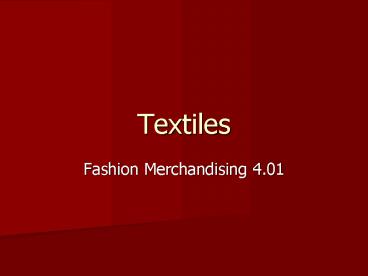Textiles - PowerPoint PPT Presentation
1 / 46
Title:
Textiles
Description:
Fabric Government Regulations Wool Products Labeling Act ... Wool products must have percentage and type of wool listed on label Textile Fiber Products ... – PowerPoint PPT presentation
Number of Views:214
Avg rating:3.0/5.0
Title: Textiles
1
Textiles
- Fashion Merchandising 4.01
2
Fiber
- Fiber the smallest unit in a textile fabric.
3
Yarn
- Yarn A group of fibers twisted together to form
a continuous strand.
4
Blend
- Blend the combination of two or more fibers
resulting in the best of each fiber.
- The picture below represents a wool, acrylic
blend.
5
Denier
- Denier Thickness or diameter of a fiber.
6
Natural Fibers
- Fibers from plants (cellulosic) and animals
(protein).
7
Cotton
- Cotton soft, white, cool to wear, underwear and
socks. PLANT.
8
Wool
- Wool coat of sheep, warmest clothes, coats and
blankets. ANIMAL.
9
Flax
- Flax stem of a PLANT, becomes linen when woven.
10
Silk
- The fine, lustrous fiber that comes from a cocoon
spun by a silkworm.
11
Leather
- Leather tough, made by preserving animal hides,
tanning.
12
Suede
- Suede leather with a napped surface.
13
Fur
- Fur soft, hairy coat of an animal, outerwear,
trimmings, come from hides.
14
Manufactured Fibers
- Fibers that are man-made and begin as thick
liquids.
15
Polyester
- Polyester made from coal, often blended with
other fibers, washes great.
16
Nylon
- Nylon dries quickly, resists wrinkles, clings to
the wearer.
17
Acrylic
- Acrylic resembles wool, soft, warm, bulky, yet
lightweight.
18
Rayon
- Rayon inexpensive, weak when wet.
19
Acetate
- Acetate silky, luxurious, wrinkles easily,
neckties and lingerie.
20
Spandex
- Spandex ability to stretch, elastic feature,
dance wear.
21
Weaving
- Interlacing one or more sets of yarns at right
angles
22
Warp
- Strands that run lengthwise.
- Up and Down
23
Weft
- Strands that run crosswise.
- (right-left)
24
Bias
- Bias The diagonal grain of a fabric. It gives
(stretch).
25
Plain Weave
- The simplest and most common weave.
- Weft passes under each warp
- Chiffon/Tafetta
26
Twill Weave
- Weft passes under 2 or 3 warps
- diagonal design on the surface
- Very strong and durable
- Used in Denim
27
Satin Weave
- Weft passes under numerous warps
- produces a smooth, shiny surfaced fabric
28
Knitting
- Knitting constructing fabric by looping yarns
together.
29
Gauge
- Gauge The number of stitches, or loops, per inch
in a knitted fabric.
30
Weft Knit
- One yarn runs crosswise to form a horizontal row
of loops - Cut edges will curl
- Runs if snagged
- Jersey and Sweater knits
31
Warp Knit
- Several yarns creating loops in a lengthwise
direction - Selvage Edges strong edge that does not ravel
- Very resistant to runs
- Used in lingere
32
Non-woven
- Fibers are compacted together.
- Moisture, heat, chemicals, or pressure
- Dryer Sheets
- Sterile Gowns and Caps
- Disposable Diapers
33
Quilting
- Quilted fabric. A layer of padding is sandwiched
between two layers of fabric and held in place by
stitching. - Examples of use bedspreads, placemats, and
outerwear
34
Braided
- Interlacing 3 or more yarns to form a regular
pattern
35
Laces and Nets
- Knotting, twisting, or looping yarns together
36
Finishing
- Finishing applying colors, designs, or surface
treatments to change the look, feel, performance
of fabrics.
37
Types of Finishing
- Mechanical
- finishes that are applied mechanically
- Affect the size and appearance
- Dyeing, Cutting, Brushing, Glazing, Embossing
- Chemical Finishes that become part of the
fabric through a chemical reaction - Waterproofing, Stain Resistant, Flame Resistant
38
Bleaching (Chemical)
- Bleaching chemical process that removes color,
impurities, or spots
39
Dyeing (Mechanical)
- Adding color to fiber, yarn, or fabric
40
Printing (Mechanical)
- Adding a pattern or design to the surface of a
fabric
41
Trends and Technology
- Equipment and Machinery
- Faster, more efficient
- CAD Computer aided design
- Microfibers
- Ultra-fine, soft, luxurious, inexpensive
- High-performance
- Sportswear
- Wicking pulls sweat away, keeps body cooler
42
Trends and Technology
- Non-Wovens
- Medical textiles protection from bodily fluids
- Protection from hazardous materials
- SPF Garments
- Individuality
- Customize garments
- (monograms)
- Recycling
43
Plastic Soda Bottles
- Plastic soda bottles recycled into t-shirts.
44
Fabric Government Regulations
- Wool Products Labeling Act (1939)
- Wool products must have percentage and type of
wool listed on label - Textile Fiber Products Identification Act (1958)
- All clothing labels list generic fiber content
45
Fabric Government Regulations
- Flammable Fabrics Act (1953)
- Regulates sale of highly flammable fabrics
- Prohibits extremely flammable fabrics
- http//www.youtube.com/watch?vkb4tCcnA6jo
46
Fabric Government Regulations
- Permanent Care Labeling Act (1972)
- All clothing required to have care instruction
labels - Symbols were
- introduced in 1997

